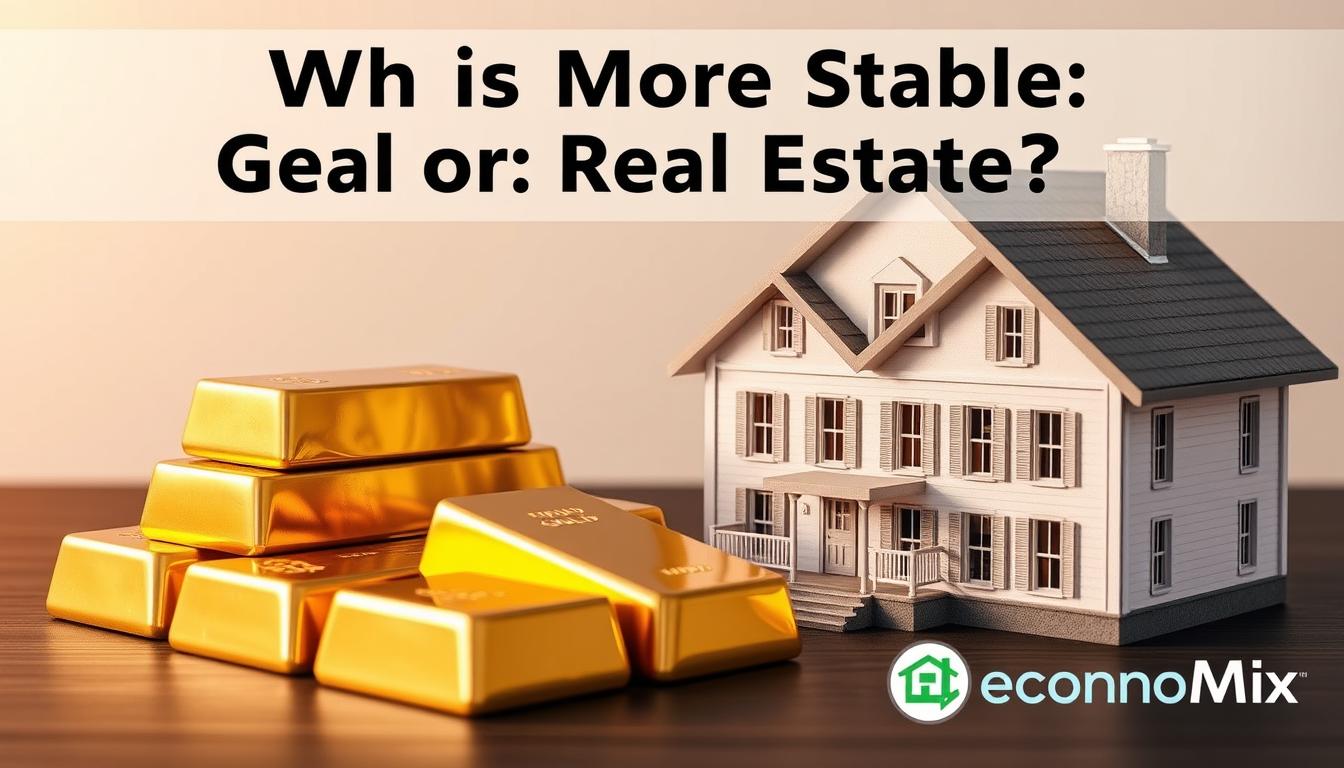In times of economic uncertainty, investors often turn to traditional stores of value like gold and real estate. Historically, both assets have provided a level of stability and protection against inflation.
Gold is renowned for its purity and universal recognition, thriving during periods of systemic distress without requiring maintenance or leverage. On the other hand, real estate is a dynamic asset that generates income and appreciates through various economic levers, offering investors a tangible means to build wealth.
The debate between gold and real estate as the more stable investment has been ongoing. Both are considered assets that can protect and grow one’s wealth, but they operate on different principles.
Key Takeaways
- Gold and real estate are both tangible assets that can provide stability in uncertain economic times.
- Gold is a low-maintenance asset that thrives during systemic distress.
- Real estate generates income and appreciates over time, offering a dynamic investment opportunity.
- The choice between gold and real estate depends on individual financial goals and risk tolerance.
- Understanding the historical performance of both assets is crucial for making informed investment decisions.
Understanding Investment Stability in Uncertain Times
In today’s volatile financial landscape, investors are increasingly seeking stable assets, such as gold real estate and property, to protect their money and portfolios. The concept of stability in investments is multifaceted, involving factors such as value retention, resistance to volatility, and predictability of performance during market fluctuations over the years.
Defining Stability in Investment Assets
Stability in investment assets refers to the ability of an asset to maintain its value over time, despite market fluctuations. This characteristic is crucial for investors seeking to minimize risk and ensure predictable returns. Assets with high stability tend to be less volatile, providing a safer haven for investors during times of economic uncertainty. The key characteristics of stable assets include value retention, volatility resistance, and performance predictability.
| Characteristics | Description | Importance |
|---|---|---|
| Value Retention | Ability to maintain value over time | High |
| Volatility Resistance | Resistance to market fluctuations | High |
| Performance Predictability | Predictable returns during market fluctuations | Medium |
Why Investors Seek Stable Assets in 2024
In 2024, investors are prioritizing stability due to persistent inflation concerns, geopolitical tensions, and market uncertainties. The economic landscape has become increasingly complex, making it essential for investors to reevaluate their portfolio allocation decisions. Different types of investors, from individual retail investors to institutional players, are defining and prioritizing stability in their investment strategies. The demand for stable assets is driven by the need for protection against risk and uncertainty in the markets.
Gold as a Stable Investment Option
Historically, gold has served as a hedge against economic crises and market volatility. Its performance is closely watched by investors seeking stability in uncertain times.
Historical Performance of Gold During Economic Crises
- Gold’s value has been tested during various economic downturns, including the 1970s stagflation period and the 2008 financial crisis. During these times, gold prices surged in the markets, providing a safe haven for investors.
- For instance, from 2000 to 2011, physical gold prices rose by 562%, driven by post-dot-com deflation fears and early quantitative easing policies, making it a valuable property for those seeking gold real access.
- Gold thrived during periods of monetary debasement and geopolitical shocks.
- It tends to underperform in expansionary or high-growth periods.
- The asset has shown a long-term Compound Annual Growth Rate (CAGR) of around 6.9% over the past 20 years.
Gold’s Role as a Safe Haven Asset
Gold is considered a traditional safe haven asset due to its ability to preserve purchasing power over centuries. Investors can gain exposure to gold real as a valuable property through various means, including physical bullion, ETFs, and mining stocks, each affecting the stability profile of the investment and influencing the price of gold in the market.
Gold’s unique properties as a non-correlated asset make it an effective tool for portfolio diversification during turbulent market conditions. Its role as a hedge against inflation and currency devaluation further solidifies its position as a stable investment option.
Real Estate’s Stability Credentials
Real estate has long been considered a stable investment option, offering a unique combination of value appreciation and income generation. This stability is rooted in its historical performance across various market cycles and economic conditions, making it a favorable choice in the context of gold real estate, housing, and home price trends.
Long-term Real Estate Value Trends
The long-term value trends of real estate have shown a consistent pattern of appreciation. From 2000 to 2023, the Case-Shiller U.S. National Home Price Index rose from 100 to over 310, representing a 210% total price increase, or approximately 5.5% annualized. This steady appreciation in property value underscores the stability of real estate as an investment asset. Moreover, real estate’s multi-dimensional return structure, including rental yield and mortgage principal reduction, enhances its appeal to investors seeking stable returns.

Income Generation and Wealth Building Through Property
Real estate offers investors multiple avenues for returns, including rental income and potential long-term wealth accumulation. Residential landlords in high-growth areas have seen significant increases in net operating income (NOI), with growth rates of 25-40% between 2019 and 2023.
This rental income provides a stabilizing cash flow component that is not typically associated with other investment assets like gold. By leveraging property investments, investors can build wealth through both passive appreciation and active value-adding strategies.
Comparing Entry Points: Accessibility and Initial Investment
When considering investment options in gold real estate, the initial entry point is a crucial factor in determining the accessibility of an asset class. Both gold and real estate, including housing and home properties, are popular investment choices, but they differ significantly in terms of their entry barriers and price.
Gold’s Low Barrier to Entry
Gold is highly accessible to investors due to its various forms, including physical bullion, ETFs, and tokenized gold on blockchain networks. This modularity makes gold attractive to both small-scale investors and institutional allocators. The minimum investment can be less than $100 via ETFs or fractional platforms, making it an attractive option for those with limited capital.
Real Estate’s Higher Entry Requirements
Real estate investing, on the other hand, typically requires more capital, paperwork, and due diligence. While traditional real estate investing has high entry requirements, alternatives like REITs and crowdfunding platforms have made property investment more accessible in recent years.
This shift towards more accessible property options contrasts with the lower barriers seen in gold real estate investment.
The minimum investment for REITs or crowdfunding can range from $10,000 to $25,000, whereas direct property ownership often requires $100,000 or more.
| Investment | Minimum Investment | Accessibility |
|---|---|---|
| Gold | <$100 | High |
| Real Estate (REITs/Crowdfunding) | $10,000-$25,000 | Moderate |
| Real Estate (Direct Ownership) | $100,000+ | Low |

The difference in entry points between gold and real estate affects not only investor participation but also portfolio allocation strategies. Investors with limited capital may prefer gold due to its low barrier to entry, while those with more substantial resources may opt for real estate for its potential long-term benefits.
Which Is More Stable: Gold or Real Estate?
The stability of gold versus real estate as investment options can be assessed by analyzing their behavior during different economic scenarios. Both assets have unique characteristics that influence their performance under various market conditions.

Stability During Economic Downturns
During economic downturns, such as the 2008 financial crisis and the 2020 pandemic shock, gold prices have often demonstrated resilience. Historically, gold has maintained its value or even appreciated during such periods, acting as a safe-haven asset.
In contrast, real estate prices can be more volatile, experiencing significant declines during economic crises. However, real estate has shown the ability to recover and provide long-term value to investors who can hold through market fluctuations.
Performance During Inflationary Periods
Gold has traditionally served as an inflation hedge, with its value increasing in response to rising inflationary pressures. For instance, during the 1970s, gold prices surged over 1,700% as inflation soared. While real estate can also benefit from inflation, as property values and rental income may increase, its performance is more nuanced and dependent on factors like location and market conditions.
In conclusion, both gold and real estate offer stability in different ways. Gold excels as a safe-haven asset during economic downturns and inflationary periods, while real estate provides long-term value and potential for income generation, albeit with higher volatility during economic shocks.
Maintenance and Ongoing Costs
The long-term viability of gold and real estate investments depends on understanding and managing their ongoing costs. Investing in gold and real estate comes with distinct ongoing costs that can significantly impact their stability and returns.
Cost of Holding Gold
Gold is often considered a low-maintenance investment, particularly when held in physical form. However, investors must consider storage costs, which can range from 0.5% to 1% of the total value annually, depending on the security tier. Additionally, insurance is a necessary expense to protect against loss or theft. For investors in gold ETFs or other investment vehicles, management fees are another cost to consider.
Real Estate Maintenance and Management Expenses
Real estate investments come with more substantial ongoing expenses. Property taxes can range from 0.7% to 2.5% of the assessed value annually, depending on the jurisdiction.
Maintenance costs, typically around 1% of the property value per year, are also a significant consideration, not to mention potential capital expenditures for renovations. Furthermore, property management fees and homeowner association fees can add to the overall cost.
When comparing gold and real estate, it’s clear that while gold has lower ongoing costs, real estate expenses can vary widely based on location, property type, and scale. Investors must weigh these costs against potential returns to determine the most stable investment for their goals.
Liquidity Considerations
The liquidity of an investment is vital to its overall stability, particularly for assets like gold and real estate. Liquidity refers to how quickly an asset can be converted into cash without significantly affecting its market price.
Gold’s High Liquidity Advantage
Gold is renowned for its high liquidity due to its global recognition and demand. Investors can easily sell physical gold in virtually any market condition, often within a few days.
This rapid conversion capability allows investors to capitalize on market trends or meet financial obligations promptly. The liquidity of gold contributes significantly to its appeal as a stable investment.
Real Estate’s Liquidity Challenges
In contrast, real estate is characterized by its illiquidity. The process of selling a property can take considerable time, often extending to several months or even longer for commercial properties.
This prolonged time frame restricts an investor’s flexibility and ability to respond to changing market conditions or financial needs. Transaction costs and the challenge of finding buyers during market downturns further exacerbate the liquidity challenges associated with real estate.
As investors evaluate the stability of their investments, understanding the liquidity dynamics of gold and real estate is crucial. While gold offers high liquidity, real estate presents significant liquidity challenges.
Modern investment vehicles like REITs and gold ETFs have somewhat mitigated these issues, offering alternative avenues for investors seeking liquidity in these asset classes.
Tax Implications for Investors

The tax treatment of gold and real estate investments can significantly impact their overall stability and after-tax returns. Investors must understand these implications to make informed decisions.
How Gold Investments Are Taxed
In the U.S., physical gold is taxed as a collectible under IRS rules. This classification affects long-term capital gains rates for investors holding gold for over a year. Short-term gains are taxed as ordinary income, at rates up to 37%.
Long-term gains on physical gold or gold-backed ETFs are subject to a maximum federal rate of 28%, higher than the typical long-term capital gains rate applied to stocks and real estate.
Real Estate Tax Advantages and Considerations
Real estate is taxed as investment property and comes with various deductions, deferral opportunities, and income treatment options. Rental income is taxed as ordinary income, but operating expenses are fully deductible. Investors can claim depreciation on the property over 27.5 years (residential) or 39 years (commercial), reducing taxable rental income. For more insights, visit this article on tax implications for gold and real estate.
Special tax considerations like 1031 exchanges for real estate allow for tax-deferred growth, enhancing investment stability through tax efficiency.
Conclusion: Making the Right Choice for Your Investment Goals
In conclusion, the debate between gold and real estate as the more stable investment option hinges on individual investor goals and risk tolerance. Investors seeking a low-maintenance, liquid asset that performs well during economic uncertainty may find gold to be an attractive choice. On the other hand, those looking for a tangible asset that can generate income and appreciate over time may prefer real estate.
The stability of gold and real estate is influenced by different market factors. Gold is often used as a hedge against inflation and market volatility, while real estate values are typically driven by local market conditions, interest rates, and economic growth. Understanding these dynamics is crucial for making informed investment decisions.
A diversified investment portfolio that includes both gold and real estate can provide a balance between liquidity, income generation, and long-term wealth appreciation.
For investors looking to mitigate risk, allocating a portion of their portfolio to gold can offer protection against market downturns, while real estate can provide steady returns through rental income and property appreciation.
Ultimately, the decision between gold and real estate should be based on an individual’s financial situation, investment goals, and risk tolerance. By understanding the unique characteristics and benefits of each asset class, investors can make more informed decisions that align with their long-term financial objectives.
FAQ
▶
▶
▶
▶
▶
▶
▶













